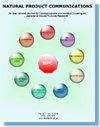Phlomis longifolia Boiss.气生部分(花、花萼、叶):GC-MS 分析和生物特性
IF 1.4
4区 医学
Q4 CHEMISTRY, MEDICINAL
引用次数: 0
摘要
目的/背景:Phlomis longifolia Boiss.因此,本研究旨在首次鉴定从叙利亚长叶白头翁植物气生部分提取的精油中具有潜在药理特性的化学成分。研究方法从叙利亚拉塔基亚省的山区采集了该植物的气生部分。随后,使用 Clevenger 型仪器通过水蒸馏法提取精油(花的收率为 0.14%,萼的收率为 0.075%,叶的收率为 0.19%),并通过气相色谱-质谱联用仪(GC-MS)进行分析。结果:在花、花萼和叶中分别鉴定出 63、61 和 48 种化合物,占油总量的 98.0%、97.1% 和 97.9%。在花的精油中鉴定出的主要化合物有:威得醇(29.8%)、β-茶叶烯(9.7%)和(E)-nerolidyl acetate(5.8%)。而花萼的精油中则有(E)-乙酸nerolidyl酯(8.6%)、α-胡麻烯(8.1%)和β-石竹烯(7.7%)。香叶精油包括(E)-nerolidyl acetate (11.4%)、β-caryophyllene (9.5%)、α-amorphene (8.8%)、caryophyllene oxide (6.7%)、α-humulene (5.3%) 和 3,5-二羟基-6-甲基-2,3-二氢-4H-吡喃-4-酮 (5.2%)。此外,根据已发表的文献,大部分已鉴定化合物都具有不同的生物活性。结论在这项研究中,首次采用气相色谱-质谱法测定了从龙脑香叶(P. longifolia)气生部分提取的精油的化学成分。萜烯类化合物是精油的主要化学成分(花为 83.3%,萼为 72.7%,叶为 80.9%),其中倍半萜类化合物的含量最高(花为 77.3%,萼为 65.7%,叶为 77.1%)。这些化合物以其多样的生物活性而闻名,促进了此类植物在植物药物中的应用。本文章由计算机程序翻译,如有差异,请以英文原文为准。
Essential Oils from Phlomis longifolia Boiss. & C.I. Blanche. Aerial Parts (Flowers, Calyxes, Leaves): GC-MS Analyzes and Biological Properties
Objective/Background: Phlomis longifolia Boiss. & C.I. Blanche. is one of the significant medicinal plants extensively utilized in folk medicine in Syria. So, this study aimed to identify the chemical components with potential pharmacological properties of essential oils extracted from the aerial parts of the Syrian P. longifolia plant for the first time. Methods: The aerial parts of the plant were collected from a mountainous area in Latakia Province, Syria. Subsequently, the essential oils were obtained using hydrodistillation with a yield of (0.14% for flowers, 0.075% for calyxes, and 0.19% for leaves) using a Clevenger-type apparatus and analyzed by gas chromatography coupled with mass spectrometry (GC-MS). Results: A total of 63, 61, and 48 compounds, which represent (98.0%, 97.1%, and 97.9%) of the total oils, were identified for flowers, calyxes, and leaves, respectively. The major compounds identified in the flower's essential oil were: widdrol (29.8%), β-caryophyllene (9.7%), and (E)-nerolidyl acetate (5.8%). While in the calyx's essential oil were: (E)-nerolidyl acetate (8.6%), α-humulene (8.1%), and β-caryophyllene (7.7%). As for the leave's essential oil were: (E)-nerolidyl acetate (11.4%), β-caryophyllene (9.5%), α-amorphene (8.8%), caryophyllene oxide (6.7%), α-humulene (5.3%), and 3,5-dihydroxy-6-methyl-2,3-dihydro-4H-pyran-4-one (5.2%). Additionally, the majority of the identified compounds have various biological activities, according to the published literature. Conclusion: In this work, the chemical composition of essential oils extracted from the aerial parts of P. longifolia was determined for the first time by GC-MS. Terpenes were the dominant chemical content of essential oils (83.3% for flowers, 72.7% for calyxes, and 80.9 for leaves), and sesquiterpenes had the highest concentration among them (77.3% for flowers, 65.7% for calyxes, and 77.1% for leaves). These compounds are known for their diverse biological activities and promote the use of such plants in phytopharmaceuticals.
求助全文
通过发布文献求助,成功后即可免费获取论文全文。
去求助
来源期刊

Natural Product Communications
工程技术-食品科技
CiteScore
3.10
自引率
11.10%
发文量
254
审稿时长
2.7 months
期刊介绍:
Natural Product Communications is a peer reviewed, open access journal studying all aspects of natural products, including isolation, characterization, spectroscopic properties, biological activities, synthesis, structure-activity, biotransformation, biosynthesis, tissue culture and fermentation. It covers the full breadth of chemistry, biochemistry, biotechnology, pharmacology, and chemical ecology of natural products.
Natural Product Communications is a peer reviewed, open access journal studying all aspects of natural products, including isolation, characterization, spectroscopic properties, biological activities, synthesis, structure-activity, biotransformation, biosynthesis, tissue culture and fermentation. It covers the full breadth of chemistry, biochemistry, biotechnology, pharmacology, and chemical ecology of natural products.
Natural Product Communications is a peer reviewed, open access journal studying all aspects of natural products, including isolation, characterization, spectroscopic properties, biological activities, synthesis, structure-activity, biotransformation, biosynthesis, tissue culture and fermentation. It covers the full breadth of chemistry, biochemistry, biotechnology, pharmacology, and chemical ecology of natural products.
 求助内容:
求助内容: 应助结果提醒方式:
应助结果提醒方式:


